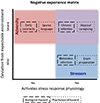Early Adversity and Critical Periods: Neurodevelopmental Consequences of Violating the Expectable Environment
- PMID: 32101708
- PMCID: PMC8092448
- DOI: 10.1016/j.tins.2020.01.002
Early Adversity and Critical Periods: Neurodevelopmental Consequences of Violating the Expectable Environment
Abstract
It is now widely recognized that children exposed to adverse life events in the first years of life are at increased risk for a variety of neural, behavioral, and psychological sequelae. As we discuss in this paper, adverse events represent a violation of the expectable environment. If such violations occur during a critical period of brain development, the detrimental effects of early adversity are likely to be long lasting. Here we discuss the various ways adversity becomes neurobiologically embedded, and how the timing of such adversity plays an important role in determining outcomes. We conclude our paper by offering recommendations for how to elucidate the neural mechanisms responsible for the behavioral sequelae and how best to model the effects of early adversity.
Keywords: adverse childhood experiences; brain development; critical periods; developmental programming; early adversity; neurobiological embedding.
Copyright © 2020 Elsevier Ltd. All rights reserved.
Figures




References
-
- Lanier P, Maguire-Jack K, Lombardi B, Frey J & Rose R.A. (2018). Adverse Childhood Experiences and Child Health Outcomes: Comparing Cumulative Risk and Latent Class Approaches. Maternal Health Journal, 22(3): 288–297. - PubMed
-
- Shonkoff JP, Garner AS, and the committee on psychosocial aspects of child and family health, committee on early childhood, adoption, and dependent care, and section on developmental and behavioral pediatrics (2012). The lifelong effects of early childhood adversity and toxic stress. Pediatrics, 129:e232–e246 - PubMed
-
- Purewal Boparai SK, Au V, Koita K, Oh DL, Briner S, Burke Harris N & Bucci M (2018). Ameliorating the biological impacts of childhood adversity: A review of intervention programs. - PubMed
Publication types
MeSH terms
Grants and funding
LinkOut - more resources
Full Text Sources
Research Materials

